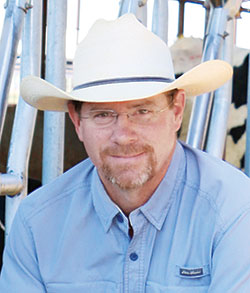The author is the founder of DNMCmilk, which works with dairy producers and heifer growers in multiple Western states.

I know of a successful producer who is proud that he hasn’t changed his ration in years. When I consider how well his cows milk, I am not sure I can criticize his thoughts and position. Still, there are certainly changes with new crop silages and other unavoidable forage changes to be addressed.
The point, though, is that cows like consistency. But what if the cows aren’t milking up to expectations? How often in this more challenging situation should rations be changed?
A broad perspective
It is true that when things are going well, ration tweaks are just that — tweaks for things like corn silage crop changes. When things aren’t going so well at the dairy, the temptation is to keep changing the diet until you find the sweet spot. This approach doesn’t feel very scientific, but if the cows just aren’t milking, it seems impossible to not change something. But is this the best way?
What, then, is the best ration approach when the cows are underperforming? It is not any different than routine ration modeling. Yes, you may dig deeper, look harder, and ask more questions, but don’t end up in a bad place one small step at a time.
There are times when a nutritionist might ask for help in tough situations from a colleague, a tech service individual, or maybe a university researcher. This step often happens after several changes have already been made on the farm. In such a circumstance, the nutritionist might say, “I’m not proud of this diet, but here it is. Let me know what you think.”
As an example, if a group of cows is seemingly more conservative than expected with components and manure consistency, you need to be careful or you will find yourself much higher in starch and lower in forage than you would normally be for a diet. You probably wouldn’t have made this big starch move in one giant step. It is likely that you got there one little step at a time.
Back to the beginning?
In some situations, the right thing to do is literally start over. I might actually create a new client file from scratch instead of the normal approach of copying a new ration from an existing one.
This involves re-entering all of the forage analysis, and describing the animal details again to the model just to be sure all is in order. It is a true do-over that feels a lot like balancing the first diet for a new herd of cows at a new dairy.
My experience with this approach has been good. It is not commonly needed and requires a lot of work, but it might be the right next step.
Seek a second opinion
Asking colleagues to review rations is a helpful option. It is quite a big task to have someone enter all of the forage and ingredient analysis along with the animal details.
When this step is needed, it is helpful to pick a colleague who uses a different formulation model. Comparing notes between two models might offer some insight in how to make a well-thought-out next step to get the cows back on track.
Much of this feels like an investigation of a crime scene. What are we missing? What do we think is true but, in reality, is not?
The list of potential pitfalls along the way between the computer and the bunk is a long one. Going through that list in a methodical fashion, checking and double-checking everything is a must.
Intensifying the number and frequency of ingredient and ration analysis is always smart when rations are not performing as expected. It could be that the near infrared (NIR) analysis package that is used routinely needs to be replaced by wet chemistry methods to drill down and be sure the formulated nutrients are in fact what the cows are consuming.
Employing new analytical tools like milk fatty acid analysis can help us learn more about the ration and the resulting milk composition. Using string samples (groups or pens of cows) for this can help even more. Milk fatty acid analysis can help us better understand how well the rumen is digesting fiber and provide some insight into body weight loss.
This new tool for evaluating milk not only offers input on ration formulation but on other potential issues, including pen crowding, available bunk space, feed push-up schedule, and so forth. This exciting tool can offer great insight into causes of disappointing milk production.
Both art and science
Formulating rations and feeding cows is both art and science. When the pressure is on to improve milk production, looking deep into both is the key. Ask for help quicker than you might think you need it. Look harder, ask more questions, spend more time with the cows, talk to the feeders, send in more samples to the lab, and request more detailed analysis packages.
Dairy producers and their nutritionists should resist the urge to try frequent and seemingly endless ration tweaks looking for the fix. But at the same time, you cannot just sit and do nothing.
In the medical world, there is the principal to above all, do no harm. Perhaps in the nutrition world, the analogous sentiment is above all, never feed an unsafe ration while chasing milk. It will come back to bite you. Trust the science, trust your experience, and above all, listen to the cows. They always tell the truth.









